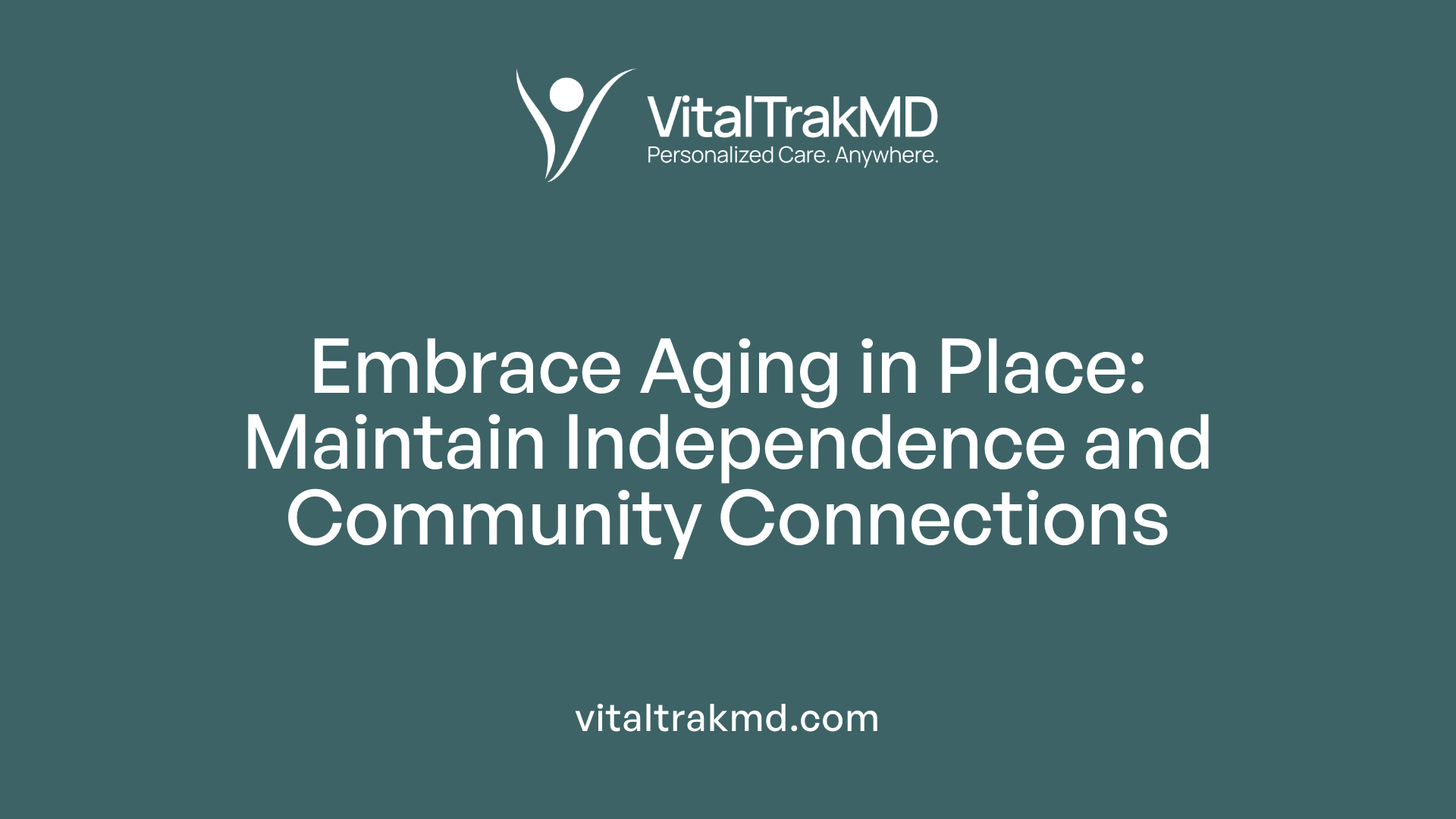Why Home-Based Wellness Services Are Essential for Aging Adults

Understanding the Importance of In-Home Care and Wellness for Seniors
As the aging population grows, the need for tailored, accessible, and comprehensive home-based wellness services becomes increasingly vital. These services enable older adults to maintain their independence, enhance their quality of life, and age comfortably within their familiar surroundings. This article explores why home-based wellness is essential, covering benefits, safety, holistic approaches, and the evolving landscape of senior care.
The Benefits of Aging in Place and How Home-Based Services Support This Choice

What are the benefits of aging in place?
Aging in place allows older adults to stay in their own homes, maintaining independence and control over their daily lives. This setting is familiar, comfortable, and promotes a sense of stability. Being in a familiar environment can boost mental well-being and improve cognitive function, especially for those with dementia or Alzheimer’s disease.
It also enables seniors to stay connected with their community, friends, and family, which helps reduce feelings of loneliness and social isolation. Opportunities for social engagement and emotional support are more accessible, contributing to better mental health.
Home modifications—like installing grab bars, ramps, and improved lighting—along with community support systems, bolster safety by reducing risks of falls and injuries. Access to services such as home health care, transportation, meal delivery, and volunteer companionship further supports independence. These measures help manage chronic conditions and daily activities effectively.
From an economic perspective, aging in place can be more cost-effective than institutional care. It often requires less financial investment in long-term facility expenses. Families benefit from reduced costs associated with nursing homes or assisted living.
Overall, aging in place offers a holistic approach, improving quality of life through comfort, familiarity, and ongoing engagement with one's environment, supported by a range of home-based and community care services.
Home Safety as a Cornerstone of Elderly Independence

Why is home safety important for older adults?
Home safety plays a crucial role in maintaining independence and well-being for older adults. It helps prevent accidents such as falls, fires, burns, and poisonings, all of which can have severe health consequences. Implementing safety measures is vital to creating a secure environment that supports active aging.
Home safety measures and their importance
Simple safety improvements can make a significant difference. For example, well-lit walkways, grab bars near toilets and in showers, smoke and carbon monoxide detectors, and non-slip mats and rugs help reduce accident risks. Keeping emergency contact information visible and accessible ensures rapid response in case of emergencies. Regularly checking for hazards like clutter, loose rugs, or electrical issues further enhances safety.
Common hazards and how to prevent them
Older homes often contain hazards that can be mitigated with proper precautions. Falls are the most common concern, so removing tripping hazards like loose cords or uneven flooring is essential. Installing handrails on stairs and ensuring rooms are brightly lit reduces fall risks. Fireplaces, stoves, and electrical appliances should be properly maintained, and fire extinguishers should be accessible. Poisoning from medications or household chemicals can be avoided by storing these items out of reach and properly disposing of expired medicines.
Role of safety modifications and health management
Safety modifications include installing grab bars, handrails, automatic lighting, and fire safety devices. These adaptations support mobility and prevent accidents. Coupled with effective health management—such as proper medication adherence and regular health monitoring—these efforts create a comprehensive safety framework.
A safe living environment helps older adults manage daily activities confidently, reduces the chance of injuries, and encourages independent living. Regular assessments and updates to safety measures, aligned with health status, are essential to sustain this safety net.
For more tips, searching for "Home safety tips for seniors" can provide additional advice tailored to individual needs.
The Advantages of Tailored Home-Based Care for Seniors

What are the advantages of home-based care for the elderly?
Home-based care provides numerous benefits that significantly enhance the well-being of older adults. Remaining in familiar surroundings helps reduce the stress and disorientation often associated with moving to institutional settings. This environment encourages a sense of independence, allowing seniors to maintain their daily routines and dignity.
Personalized care is a hallmark of home services. Caregivers can develop tailored plans that meet each individual's specific health needs, whether it's medication management, wound care, or chronic disease monitoring. This one-on-one attention often results in better health outcomes and fosters strong, trusting relationships.
Cost-effectiveness is another advantage. Families generally pay only for specific services required, which can be more affordable than the expenses associated with nursing homes or assisted living facilities.
Privacy and safety are preserved in the home setting. Seniors have greater control over their environment, which can reduce anxiety and promote comfort. Additionally, home care minimizes exposure to infections, such as COVID-19, that are common in crowded institutional settings.
By focusing on holistic and personalized support, home-based elderly care supports aging in place, helping seniors stay active, engaged, and healthier longer.
What types of services are provided at home?
Home health care services encompass a wide range of medical and support activities. Skilled nurses assist with injections, wound care, blood sugar monitoring, and management of chronic conditions like hypertension. Caregivers or aides support activities of daily living such as bathing, dressing, grooming, grocery shopping, cooking, and light housekeeping.
Other services include companionship programs, which offer emotional support and relieve caregiver burden. Transportation services help older adults attend medical appointments or social activities. Emergency alert systems provide safety monitoring, especially for those living alone.
Specialized services like physical therapy, speech therapy, or respite care for family caregivers further support recovery and independence. Comprehensive assessments often guide the development of tailored care plans to address individual needs.
How do cost and privacy considerations influence home-based care?
While home care offers many benefits, costs can vary depending on the level of assistance needed. Basic aide services may be affordable, but specialized nursing or around-the-clock care can be expensive, making insurance coverage and government programs like Medicaid important resources.
Privacy is highly valued by seniors, as being cared for at home ensures they maintain control over their personal space and daily routines. Unlike in institutional settings, they can enjoy the comfort and familiarity of their own environment, which can positively influence mental health and overall satisfaction.
Overall, personalized in-home care combines medical expertise with respect for privacy, fostering a supportive environment for aging adults to thrive.
Understanding Home Health Care Services for Older Adults

What does home health care for the elderly include?
Home health care for seniors involves a range of medical and supportive services delivered in the comfort of their homes. Skilled care services, provided by licensed healthcare professionals, are central to these offerings. These include nursing care, physical therapy, occupational therapy, speech-language pathology, and social services aimed at managing health conditions.
In addition to skilled services, home health aides may assist with daily tasks such as wound care, medication administration, injections, and monitoring of chronic or complex health issues. These services help seniors recover from surgery, manage illnesses like diabetes, or handle ongoing health needs.
To qualify for home health services, individuals typically need to be homebound, require intermittent or part-time skilled care, and have a care plan developed by a healthcare provider. Importantly, services like meal delivery, general housekeeping—unless related to medical needs—and personal care are usually not covered under Medicare.
Most Medicare beneficiaries incur no out-of-pocket costs for covered home health services, although co-insurance may apply after deductibles. This comprehensive approach ensures seniors receive necessary medical support directly at home, promoting independence and well-being.
| Service Type | Description | Additional Details |
|---|---|---|
| Skilled Nursing | Medical care administered by registered nurses | Wound care, injections, health monitoring |
| Therapy Services | Physical, occupational, speech therapy | Aid recovery and maintain functionality |
| Home Health Aide | Personal assistance with daily activities | Part of broader skilled care plans |
| Medical Social Services | Support for mental health and social needs | Counseling and resource coordination |
How do eligibility and coverage work?
To access these services, patients must meet specific criteria: being homebound, needing skilled nursing or therapy intermittently, and having a care plan sanctioned by a healthcare professional. While the services are generally covered at no cost under Medicare, patients may have small co-insurance charges after meeting deductibles. Non-medical services such as general housekeeping or meal delivery, although helpful, are usually paid out-of-pocket or through other community programs.
What are the differences between skilled medical care and custodial services?
Skilled medical care includes professional services like nursing, therapy, and medical social work. These are provided by licensed health professionals and are intended to treat, diagnose, or manage health conditions.
Conversely, custodial services mainly consist of assistance with daily living activities—such as bathing, dressing, grooming, and meal preparation—that do not require medical skills. These services are often delivered by home helpers or family members and are typically not covered by Medicare unless part of a broader healthcare plan.
The Impact of Holistic Wellness Approaches on Elderly Health
How can holistic wellness approaches improve health and well-being in older adults?
Holistic wellness strategies encompass physical, emotional, mental, and social aspects of health, providing a comprehensive framework to support aging populations. These approaches recognize that well-being is interconnected across multiple dimensions, and addressing each can lead to more positive health outcomes.
Community programs and senior centers are instrumental in offering tailored activities that promote holistic health. For example, physical wellness activities like gentle exercises, walking, dancing, and stretching help maintain mobility and strength. Emotional wellness is fostered through social engagement, support groups, and opportunities for meaningful social connections, which combat loneliness and depression.
Mental health benefits are supported by educational workshops, cognitive games, and opportunities for continuous learning, keeping minds active and engaged. Social wellness is reinforced through community involvement, volunteer opportunities, and social gatherings that encourage relationship building.
These integrated efforts can lead to significant improvements in seniors’ overall quality of life. They help maintain independence, boost vitality, and provide a sense of purpose and belonging. When combined, these elements foster resilience and promote healthier, more active aging.
By adopting a holistic model, health initiatives proactively address older adults' diverse needs, resulting in better health outcomes, greater life satisfaction, and an enhanced capacity to age in place confidently.
| Wellness Dimension | Activities and Supports | Impact on Aging |
|---|---|---|
| Physical | Exercise classes, walking, dancing | Maintains mobility, reduces fall risk |
| Emotional | Support groups, social activities | Reduces loneliness, improves mood |
| Mental | Educational workshops, cognitive games | Enhances mental acuity, prevents cognitive decline |
| Social | Community engagement, volunteering | Builds relationships, promotes social support |
As the field evolves, combining these dimensions through community-based programs and personalized care plans offers older adults the best chance at healthy, fulfilling aging.
The Strategic Role of Community Resources in Supporting Aging in Place

Why are home-based wellness services essential for supporting aging in place?
Home-based wellness services play a vital role in helping older adults live confidently and comfortably in their own homes. These personalized services include assistance with everyday activities such as bathing, dressing, and mobility, which are crucial for maintaining independence.
Beyond basic support, these services also provide health management tasks like medication oversight and chronic condition monitoring, all within familiar surroundings. This approach not only promotes safety by reducing fall risks and managing health issues but also fosters emotional well-being by maintaining social connections and a sense of normalcy.
Technologies such as telehealth, GPS tracking, and smart home systems are increasingly integrated into home care, offering real-time health monitoring and prompt responses to emergencies. Community resources like volunteer programs, meal delivery, and transportation services further support older adults by addressing social and practical needs.
Supporting aging in place through these services enhances overall health outcomes. For instance, research shows that seniors utilizing home and community care have improved physical health, decreased depression scores, and experienced greater engagement in daily life. Such comprehensive support not only promotes safety and health but also sustains mental and social well-being.
Most older adults prefer to age in their homes for comfort and convenience, and with about 99% of current care happening outside the home, there is a growing shift towards increased in-home services. This trend is propelled by innovations, evolving consumer preferences, and policies recognizing the benefits of community-based aging support.
In summary, community resources and home wellness services are crucial for fostering independence, providing personalized health oversight, and improving quality of life for older adults. These services ensure that seniors can age with dignity and remain active participants in their communities.
Enhancing Senior Well-Being through Comprehensive Community and At-Home Services
 Why is home-based wellness services essential for supporting aging in place?
Why is home-based wellness services essential for supporting aging in place?
Home-based wellness services are vital for helping older adults stay in their own homes while managing health and maintaining independence. These services include assistance with activities of daily living such as bathing, dressing, grooming, and mobility support, often provided by trained aides or family members. Medical tasks like wound care, medication management, and routine health monitoring by skilled nurses ensure health issues are promptly addressed.
Besides medical care, home services also offer social and emotional support through volunteer programs that provide companionship and check-ins. Community-delivered services like meal delivery, transportation, and legal assistance help older adults access resources and maintain a good quality of life.
Innovations such as telehealth, emergency alert systems, and smart home technology further enhance care by enabling real-time health monitoring and safety. These personalized, accessible services reduce risks like falls and social isolation, allowing seniors to age comfortably and safely at home.
Research shows that implementing home and community care improves physical health (by 2.9%) and reduces depression scores significantly (by 0.471). It also enhances mental sharpness, increases participation in daily activities, and slightly boosts life satisfaction, especially among non-disabled older adults and those with low socio-economic status. These benefits underscore how comprehensive home care supports holistic health, personal dignity, and independence in aging.
In summary, integrating diverse community and home-based services creates a supportive environment for seniors, helping them maintain health, emotional well-being, and social engagement. As most older adults prefer to age in their familiar surroundings, expanding at-home care options aligns with their wishes while promoting healthier, happier aging.
Fostering Independence and Well-Being in Older Adults Through Home-Based Services
Home-based wellness services are more than just healthcare provisions; they are pivotal in enabling seniors to enjoy a dignified, independent, and fulfilling life in their own homes. By supporting physical safety, mental health, social connection, and holistic wellness, these services address the diverse needs of aging adults. The integration of innovative technologies, community programs, and personalized care enhances the effectiveness of in-home care, ensuring that seniors can age comfortably and safely. As the demand for aging-in-place options continues to grow, investing in and expanding home-based wellness services remains essential for healthcare systems, families, and communities committed to supporting healthy aging.
References
- Services for Older Adults Living at Home | National Institute on Aging
- Effect of the Use of Home and Community Care Services on the ...
- Helping older adults receive at-home and local care - CVS Health
- Caregiving: Knowing When It's Time for In-Home Help
- Benefits Of At-Home Nursing and Healthcare for Seniors
- Regular Health Monitoring at Home: Essential for Senior Wellness
- Effectiveness of a community-based integrated service model for ...
- Social factors influencing utilization of home care in community ...
- Wellness for Older Adults in Daily Life | Oklahoma State University
- Enhancing Senior Living: Integrating Wellness Services for ... - Aaniie
Recent articles
Want to Feel Better and Live Healthier?
Join hundreds of patients taking control of their health with personalized care that fits their life – not the other way around.
Rated 4.8/5 by 32+ customers







